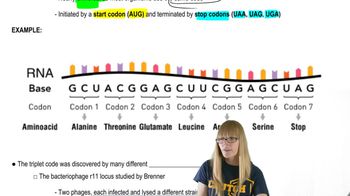Table of contents
- 1. Introduction to Genetics51m
- 2. Mendel's Laws of Inheritance3h 37m
- 3. Extensions to Mendelian Inheritance2h 41m
- 4. Genetic Mapping and Linkage2h 28m
- 5. Genetics of Bacteria and Viruses1h 21m
- 6. Chromosomal Variation1h 48m
- 7. DNA and Chromosome Structure56m
- 8. DNA Replication1h 10m
- 9. Mitosis and Meiosis1h 34m
- 10. Transcription1h 0m
- 11. Translation58m
- 12. Gene Regulation in Prokaryotes1h 19m
- 13. Gene Regulation in Eukaryotes44m
- 14. Genetic Control of Development44m
- 15. Genomes and Genomics1h 50m
- 16. Transposable Elements47m
- 17. Mutation, Repair, and Recombination1h 6m
- 18. Molecular Genetic Tools19m
- 19. Cancer Genetics29m
- 20. Quantitative Genetics1h 26m
- 21. Population Genetics50m
- 22. Evolutionary Genetics29m
17. Mutation, Repair, and Recombination
Induced Mutations
Problem 30b
Textbook Question
A fragment of a wild-type polypeptide is sequenced for seven amino acids. The same polypeptide region is sequenced in four mutants. Wild-type polypeptide N . . . Thr–His–Ser–Gly–Leu–Lys–Ala . . . C Mutant 1 N . . . Thr–His–Ser–Val–Leu–Lys–Ala . . . C Mutant 2 N . . . Thr–His–Ser–C Mutant 3 N . . . Thr–Thr–Leu–Asp–C Mutant 4 N . . . Thr–Gln–Leu–Trp–Ile–Glu–Gly . . . Determine the wild-type mRNA sequence.
 Verified step by step guidance
Verified step by step guidance1
Identify the codons for the wild-type amino acids: Thr (Threonine), His (Histidine), Ser (Serine), Gly (Glycine), Leu (Leucine), Lys (Lysine), Ala (Alanine).
Use a codon table to find possible mRNA codons for each amino acid: Thr (ACU, ACC, ACA, ACG), His (CAU, CAC), Ser (UCU, UCC, UCA, UCG, AGU, AGC), Gly (GGU, GGC, GGA, GGG), Leu (UUA, UUG, CUU, CUC, CUA, CUG), Lys (AAA, AAG), Ala (GCU, GCC, GCA, GCG).
Compare the wild-type sequence with Mutant 1, which has a single amino acid change from Gly to Val. This suggests a single nucleotide change in the Gly codon to a Val codon (GUU, GUC, GUA, GUG).
Analyze Mutant 2, which ends after Ser, indicating a possible stop codon introduced after Ser. This suggests a mutation in the Gly codon to a stop codon (UAA, UAG, UGA).
Examine Mutant 3 and Mutant 4 for additional insights, noting that Mutant 3 has a different sequence starting from the second amino acid, suggesting a frameshift or early stop, and Mutant 4 has a completely different sequence, indicating a possible frameshift mutation.
Recommended similar problem, with video answer:
 Verified Solution
Verified SolutionThis video solution was recommended by our tutors as helpful for the problem above
Video duration:
2mPlay a video:
Was this helpful?
Key Concepts
Here are the essential concepts you must grasp in order to answer the question correctly.
Genetic Code
The genetic code is a set of rules that defines how the sequence of nucleotides in mRNA is translated into the sequence of amino acids in a polypeptide. Each amino acid is specified by a codon, which is a sequence of three nucleotides. Understanding the genetic code is essential for determining the mRNA sequence that corresponds to a given polypeptide sequence.
Recommended video:
Guided course

The Genetic Code
Transcription and Translation
Transcription is the process by which the DNA sequence of a gene is copied into mRNA, while translation is the subsequent process where ribosomes synthesize proteins based on the mRNA sequence. To determine the wild-type mRNA sequence from the polypeptide, one must understand how these processes work together to convert genetic information into functional proteins.
Recommended video:
Guided course

Translation initiation
Mutations
Mutations are changes in the nucleotide sequence of DNA that can lead to alterations in the corresponding polypeptide. Analyzing the differences between the wild-type and mutant polypeptide sequences helps identify specific mutations and their potential effects on protein function. This understanding is crucial for reconstructing the wild-type mRNA sequence from the provided polypeptide data.
Recommended video:
Guided course

Mutations and Phenotypes

 4:29m
4:29mWatch next
Master Induced Mutations with a bite sized video explanation from Kylia Goodner
Start learningRelated Videos
Related Practice


